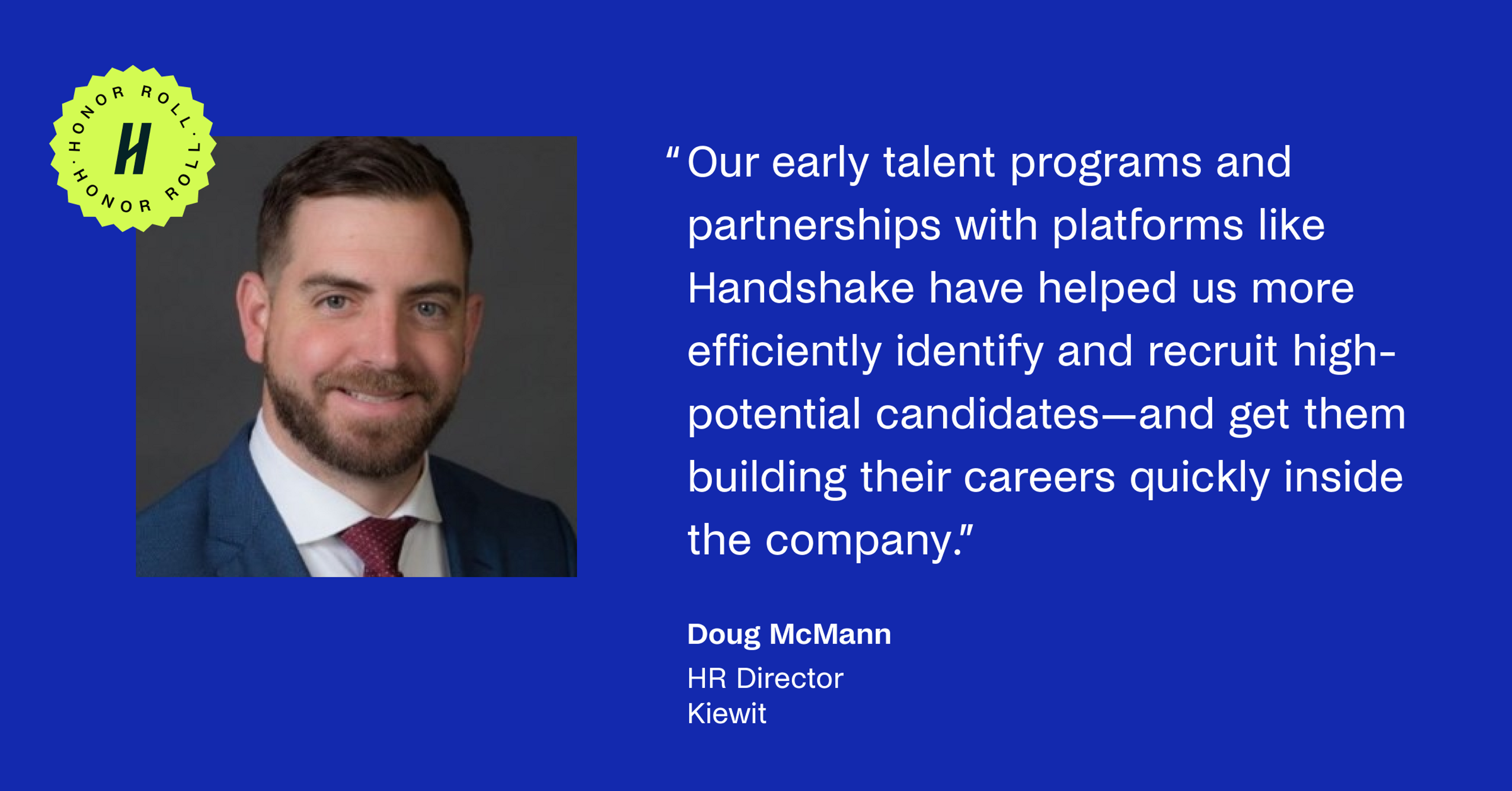Recruiting teams, we know you feel the pressure to achieve hiring goals while being as efficient and effective as possible. When you audit your strategies, you’re likely bringing out the chopping block with a pit in your stomach. What events and initiatives should you drop? Which tools can you survive without?
But cutting off your organization’s workforce pipeline at the source for the sake of budget or time can quickly turn into missed opportunities for the entire company. It limits every leader's ability to predictably identify, engage, and attract talent—specifically, the early talent—that could make a meaningful and cost-effective impact.
So, to help you turn “What can we minimize?” into “How do we optimize?” Here are 7 tips from our most successful customers who've streamlined and scaled their early talent recruiting—without sacrificing impact.
1. Start with data
Throwing proverbial spaghetti at the wall to see what sticks will inevitably lead to irrelevant matches and unproductive conversations—wasting hours and dollars. Tailor and target your hiring efforts toward the talent and the schools that best fit your skills gaps and growth needs. This isn’t about hunches or outdated only-core school strategies. With Handshake, you can access accurate data to refine your efforts:
- School Explorer makes it easy to filter different schools, identify the ones that match your hiring needs, and develop strong partnerships with those institutions.
- Talent List helps you quickly filter and sort through the more than 13 million students on Handshake based on school, major, and geographic region to reach out to talent proactively.
Think about it this way: More than 70% of 2023 graduates say they have the skills they need to get the job they want, and using data to tailor your recruitment strategy means you can focus your efforts on finding them.
Learn more tips like this from Handshake Honor Roll winner Doug McMann.
2. Build an authentic employer brand
Your employer brand communicates with candidates—long before a recruiter might communicate with them directly.
While it takes some energy upfront to fine-tune your brand and showcase all of the aspects that make your organization a great place to work, it’s well worth the investment to help you connect with prospective talent, even when you can’t literally connect with them.
Companies that create a more engaging brand experience on Handshake receive 2x more page views of their Handshake Company Profiles than organizations that don’t cultivate this same experience. These companies include elements like:
- Photos and videos
- Employee testimonials
- Student tips
- Company news
- Opportunities to connect with current employees
Need inspiration for your profile? Epic partnered with Handshake to boost their brand awareness. Epic now gets 4.7x the amount of employer page views and 4.8x the number of job views compared to industry peers, along with a 50% increase in qualified applicants.
Cultivating a strong brand helps talent better understand your company and feel a stronger connection, too. Once it’s up and running, your brand can do a lot of the talking for you—ultimately saving you time, energy, and money. Top companies using Handshake to recruit entry-level talent see up to a 7x decrease in promotional cost per hire versus the industry average.
3. Develop an advocates program
You might feel like you need to do more with less—but what if you could actually get more resources without additional costs?
That’s where your own employees come in as advocates. An advocate program taps into your organization and involves them in the recruiting process. With just a little training and some helpful templates or materials, they’re ready and equipped to promote your organization, forge bonds with early talent, and position your company as a great workplace.
Early talent appreciates this opportunity to go beyond recruiters and connect with other employees or potential teammates. The CDC DSEPD saw a 20.7% engagement rate through its network of over 400 advocates. Our research found that 55% of students said meeting an employer’s teammates would influence their decision to apply. And with virtual events, you can connect your employees with students worldwide without having to fly them anywhere or asking for a big commitment.
Think of involving advocates as a way to grow your recruitment team without actually growing your recruitment team. They can help you expand your reach and make meaningful connections with early talent while saving time and money.
4. Engage in virtual events
Post-pandemic, college campuses are bustling again, and in-person career fairs are making a comeback. But that doesn’t mean it’s time to pull the plug on virtual events.
In-person career fairs demand more time, money, and resources than virtual offerings. So, when aiming to streamline and scale your recruitment efforts, don’t neglect the importance of online events to save on-campus time and spend while connecting with a broader talent pool.
And if you’re looking to support your DEI initiatives, online events are critical. Students of color, in particular, show a preference for virtual recruiting. In spring 2023, 65% of virtual fair attendees were students of color.
With virtual events, you aren’t limited by geographic location. When 71% of the Class of 2023 say they’re willing to move to a different city for the right job or opportunity, online events allow you to engage students from all over—even if you don’t have a large on-campus presence at their school.
Virtual career fairs are also the preferred format for students, and they’ve RSVP’d 3.4x more for virtual events than in-person events YTD in 2023.
So, when crafting your hybrid recruitment strategy, be selective about which on-campus events are worth time and resources and then supplement those with a broad offering of accessible, virtual opportunities that diverse early talent is hungry for.
5. Boost your event efficiency
To make the most of your recruitment events—both virtual and in-person—your team needs to be able to keep in touch before, during, and after efficiently. That’s nearly impossible if you’re juggling stacks of resumes, random notes, and jumbled spreadsheets.
Handshake Events is an end-to-end system that helps you keep track of all of the touchpoints and stages of the candidate journey. You can easily schedule, evaluate, and track your candidates pre-, during, and post your event activities. You’ll turn chaos and confusion into a streamlined workflow for all your events and fairs.
For example, CBIZ needed to boost candidate engagement while also simplifying their recruitment processes. By hosting and managing virtual events through Handshake, they saw a 3x increase in event RSVPs year over year, a 4x increase in candidates reached year over year, and a 178% increase in sourced applications—all while saving time and in-person resources.
6. Build strong relationships
“Relationship-building” and “scalable” don’t seem to belong in the same sentence. Relationships require personalization and direct contact, both time-consuming and mentally demanding.
But technology means relationships have never been more scalable—mainly when early talent thinks online relationships are just as strong as in-person ones. An impressive 67% of Handshake Network Trends Gen Z survey respondents said that it’s not necessary to meet in person to make a professional connection.
Remember that scaling your relationship-building doesn’t mean a blanket approach filled with form letters and impersonal communication. With Handshake and smart campaigns, you can efficiently personalize messages at scale to better engage early talent.
Raymond James is an excellent example of a company that uses personalized virtual campaigns to get in front of students and make them feel unique and special. Procter and Gamble also used Handshake to encourage students to apply to open positions prior to the busy fall season and, as a result, were able to extend 85% more offers before October 15th than in previous years.
So, ditch the idea that relationship-building has to be tedious. With the right technology, it transforms from sluggish and slow to streamlined and scalable.
7. Leverage the right tools
Look at the above strategies to scale your early talent recruitment while efficiently managing time and costs, and you’ll see they have one big thing in common: the right technology.
Modernizing and streamlining your recruitment processes requires tools that help you engage students without extra time and stress. Jumping between dozens of different tools, spreadsheets, and email threads is the opposite of efficient.
Handshake is an all-in-one solution to maximize your recruiting budget. With our sourcing and engagement tools, access to a vast network of qualified candidates, event management capabilities, and strategic insights, our partners see increased job applicants, event attendees, employee satisfaction, and faster hiring times.
“Before Handshake, we were using so many systems for every part of the recruiting process. Handshake serves as our one-stop-shop for all of it; I can do everything in one place.”
Tiffanie Rice, former Vice President of DEI at Comerica Bank
Early talent recruitment: prioritize efficiency
Headwind or tailwind, taking your foot off the gas of your workforce pipeline is never the right move. Scaling back recruitment efforts too far means missing opportunities to connect with students and recent grads who are ready and raring to make an impact at your organization.
It’s less about what you can remove and more about what you can improve. And Handshake’s team is here to help.
Connect with our Handshake team to get started
Keep learning: While early talent might be new to the working world, they have the skills to make a meaningful impact from day one. Plus, they’re eager, enthusiastic, and even more cost-effective than more experienced talent on the market. Please don’t take our word for it!
Discover why David Jordan and Chris DeLisa from TD SYNNEX say that building a pipeline of early talent has changed their hiring game with 7 tips to maximize ROI on your early talent strategy. Here’s a sneak peek:

